Selecting the Right Racquet by Tennis Warehouse
Ifyou’re like most Tennis Warehouse customers, you already have an ideaof the type of racquet you’re seeking. You want to upgrade from yourcurrent racquet - maybe you’re seeking more power, more control, morecomfort... or a little of all three. Whatever your reason(s) forpurchasing a new racquet, you have some basis on which to make yourdecision.
Then again, you may not have a clue as to whichracquet is best for you and are simply motivated by a review you read.Add to the confusion the shear amount of racquets available andchoosing the right racquet becomes pretty daunting! To make thisprocess a little easier, here’s a primer on racquet characteristics andhow they affect performance. We also suggest you read our racquet reviews where you’ll find detailed information from real tennis players on how a specific racquet performs on-court. Our Racquet Technologiessection includes explanations and illustrations of racquet technologiesand materials, such as nCode, Hot Melt, Liquidmetal, and F.I.R.E., toname a few. Finally, our General Racquet & String Terms provide definitions of terms that are used throughout our website to describe racquet and string performance.
Today, there are 3 major racquet categories, with several subcategories. They are: Category 1: Power or Game Improvement Racquets
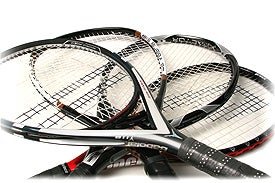 This is the term used by racquet manufacturers for power-orientedracquets. In most cases, these racquet models feature oversize tosuper-oversize heads (107-135 square inches), are lightweight (8-9.5ounces), longer (27-29 inches) stiffer and are balanced head-heavy (orevenly balanced) to retain enough weight in the hitting zone. Designedfor players with shorter, slower swings and who want more power fromthe racquet. Here are some of the top game improvement racquets: This is the term used by racquet manufacturers for power-orientedracquets. In most cases, these racquet models feature oversize tosuper-oversize heads (107-135 square inches), are lightweight (8-9.5ounces), longer (27-29 inches) stiffer and are balanced head-heavy (orevenly balanced) to retain enough weight in the hitting zone. Designedfor players with shorter, slower swings and who want more power fromthe racquet. Here are some of the top game improvement racquets: | Select Game Improvement Racquets | [tr] [/tr]
 Babolat Y 118 Smart Grip Racquets Babolat Y 118 Smart Grip Racquets
An ergonomic Smart Grip handle shape combines with a powerful responsethat's perfect for the beginning player. This one is light, stable,comfortable and well worth a demo. Headsize: 118sq. in. Length: 27.5in.Strung weight: 9.6oz.
Price: $239.00, |  PowerAngle GRAND Racquets PowerAngle GRAND Racquets
A spin-friendly and very comfortable racquet that is diagonally-strungand ideally suited to beginner through intermediate level players.Strung Weight: 9.2oz. Length: 27.3 inches.
Price: $199.00, Customer Feedback, |  Prince EXO3 Silver Racquets Prince EXO3 Silver Racquets
A power-oriented racquet with a generous sweetspot and excellent access to spin. Excellent choice for 2.0-4.0 level players. Headsize: 118 sq in. Length: 27.5". String pattern: 16/19.
Price: $279.00, Customer Feedback, |  Volkl Power Bridge 1 Racquets Volkl Power Bridge 1 Racquets
An extremely powerful, comfortable and spin friendly racquet. Wellsuited to beginners to 3.5 NTRP level players seeking maximum resultsfrom minimum efforts. Headsize: 115sq. in. Length: 27.8 in. StrungWeight: 9.3oz.
Price: $249.99, Customer Feedback, |  Wilson K Factor KZero Racquets Wilson K Factor KZero Racquets
A great choice for beginners seeking a game improvement racquet. TheKZero is the lightest racquet in the K Factor line. Impressive powerand control. Super oversize head: 118 sq. in. Length: 27.5 inches.
Price: $99.95, Customer Feedback, |  Yonex S-Fit 5 Racquets Yonex S-Fit 5 Racquets
A powerful and arm-friendly racquet, this one is perfect for beginnerthrough intermediate level players. Headsize: 112sq. in. Length: 27.25in. Strung weight: 9.9oz.
Price: $219.00, Customer Feedback, |
Category 2: ‘Tweener Racquets
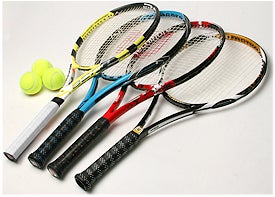 There are several models that offer a blend of features from gameimprovement and player’s racquets. They are often light-er (9.5-11ounces), balanced anywhere from slightly head-light to slightlyhead-heavy, have midplus (95-102 square inches) heads and are usuallyextended length (27.5-28 inches). These racquet models offer low-mediumto medium-high power and are most appealing to intermediate-advancedplayers, seeking enhanced maneuverability. Here are some of the top'tweener racquets: There are several models that offer a blend of features from gameimprovement and player’s racquets. They are often light-er (9.5-11ounces), balanced anywhere from slightly head-light to slightlyhead-heavy, have midplus (95-102 square inches) heads and are usuallyextended length (27.5-28 inches). These racquet models offer low-mediumto medium-high power and are most appealing to intermediate-advancedplayers, seeking enhanced maneuverability. Here are some of the top'tweener racquets: | Select Tweener Racquets |  Babolat Pure Drive Cortex Racquets Babolat Pure Drive Cortex Racquets
Babolat's hugely popular Pure Drive gets updated with new Cortex technology. Offers the same great playability with more comfort and a solid feel.
Price: $159.00, Review, Customer Feedback, |  Babolat Pure Drive GT Racquets Babolat Pure Drive GT Racquets
A new Graphite/Tungsten construction makes this the most solid PureDrive to date. Standard length. Strung Weight: 11.2oz Headsize: 100sq.in.
Price: $185.00, Review, Customer Feedback, |  Boris Becker Pro Racquets Boris Becker Pro Racquets
A versatile racquet that offers impressive power and excellent accessto spin for intermediate to advanced players. Maneuverable andcomfortable, this racquet is ideal for today's topspin power hitting.Headsize: 100sq. inches. Standard length.
Price: $99.00, Customer Feedback, |  Dunlop Aerogel 4D 500 (5Hundred) Racquet Dunlop Aerogel 4D 500 (5Hundred) Racquet
This spin-friendly, light weight racquet is extremely maneuverable aswell as forgiving. A great choice for the player looking to transitionto a higher level. Head size: 100 square inches. Strung weight: 10.2ounces. Length: 27.0".
Price: $159.00, Customer Feedback, |  Volkl Power Bridge 8 Racquets Volkl Power Bridge 8 Racquets
Advanced power hitters and improving intermediate players will love thespin potential and comfort from this versatile racquet. Offers improvedfeel over most competing racquets. Headsize: 100sq. inches. Strungweight: 11 ounces. Standard length.
Price: $179.99, Customer Feedback, |  Wilson K Factor Kobra Tour Racquets Wilson K Factor Kobra Tour Racquets
Offering excellent pop, good spin, and a good, solid feel, the [K]obrais a great choice for a variety of playing styles. 100 sq. inch head.27" length. 16/19 string pattern.
Price: $189.00, Customer Feedback, |  Yonex RDiS 300 Midplus Racquets Yonex RDiS 300 Midplus Racquets
A maneuverable and spin friendly racquet that offers a crisp yetcomfortable response. A solid choice for 4.0+ level all court players.Headsize: 100sq. inches. Length: 27 inches. Stiffness: 62RA.
Price: $169.00, Customer Feedback, |
Category 3: Control or Player’s Racquets
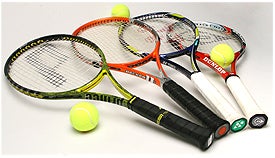 Denotes racquets that would be used by professional and high-level cluband college team players. These models are typically heavier in weight(11.5-13+ ounces), have smaller heads (85-98), thinner, more flexiblebeams and are balanced head light to retain maneuverability. The resultis a low-power racquet, designed for players who provide their ownpower and prefer a racquet that offers more control. Can be standard orextended length. Here are some of top player's racquets: Denotes racquets that would be used by professional and high-level cluband college team players. These models are typically heavier in weight(11.5-13+ ounces), have smaller heads (85-98), thinner, more flexiblebeams and are balanced head light to retain maneuverability. The resultis a low-power racquet, designed for players who provide their ownpower and prefer a racquet that offers more control. Can be standard orextended length. Here are some of top player's racquets: | Select Player's Racquets |  Babolat Pure Storm Ltd. Racquets Babolat Pure Storm Ltd. Racquets
A control oriented player's racquet that impresses with its feel andstability from all areas of the court. Best suited to 4.5+ levelplayers who generate their own power. Standard length. Headsize: 95sq.inches.
Price: $129.00, Customer Feedback, |  Boris Becker 11 Racquets Boris Becker 11 Racquets
Offering a very high level of feel and control for advanced players(4.5+), the Becker 11 provides a responsive feel akin to the classicVolkl player's racquets. Headsize: 98sq. inches. Strung Weight: 12 oz.String Pattern: 18/20.
Price: $99.99, Review, Customer Feedback, |  Dunlop Aerogel 4D 200 (2Hundred) Racquet Dunlop Aerogel 4D 200 (2Hundred) Racquet
Adding strength and stability with directional braiding, 4D, Dunlop hasmade the latest 2hundred even more solid than the last. String Pattern:18/20. Head size: 95 square inches. Strung weight: 11.9 ounces.
Price: $179.00, Customer Feedback, |  Head YOUTEK Speed Pro Racquets Head YOUTEK Speed Pro Racquets
The Speed Pro is as solid as a rock and with excellent feel. This oneis well suited to aggressive, advanced players. Standard length.Midplus 98sq. in.
Price: $199.95, Review, Customer Feedback, |  Prince EXO3 Rebel 95 Racquets Prince EXO3 Rebel 95 Racquets
The racquet choice of ATP Tour Professional Gael Monfils,this player's racquet offers the utmost in control and precision with ahot-knife-through-butter smoothness. Headsize: 95 sq. in. Standardlength. String pattern: 18/20.
Price: $189.00, Review, Customer Feedback, |  Volkl Power Bridge 10 Mid Racquets Volkl Power Bridge 10 Mid Racquets
A very impressive player's racquet that is loaded with feel andcontrol. The open string pattern offers excellent access to spin andample pace that results in a heavy ball. Headsize: 93sq. in. Standardlength. Beam width: 19mm.
Price: $189.99, Review, Customer Feedback, |  Wilson BLX Six.One Tour Racquets Wilson BLX Six.One Tour Racquets
Loaded with control and stability, this one offers a slightly moredampened feel compared to previous Six.One Tours. Awesome control forthe 5.0+ level player. Strung weight: 12.5oz. Swingweight: 333 (RDC).
Price: $199.00, Review, Customer Feedback, |  Wilson K Factor KPro Staff 88 Racquets Wilson K Factor KPro Staff 88 Racquets
Pete Sampras'choice and the racquet equivalent of combining axe like power withscalpel like precision. Best suited to stronger, advanced level players(NTRP 5.0+). Strung weight: 12.8oz. Stiffness: 67 (RA). Swingweight:345 (RDC).
Price: $199.00, Review, Customer Feedback, |  Yonex RDiS 100 Mid Racquets Yonex RDiS 100 Mid Racquets
Providing a firm and crisp response, this racquet is well suited toadvanced level players. The 12.1 ounce strung weight and 68RA stiffnesscombine for excellent power and stability in a player's racquet.Midsize: 93sq. inches.
Price: $179.00, Customer Feedback, |
When making a racquet choice,
you’ll need to consider the following features: Head Size
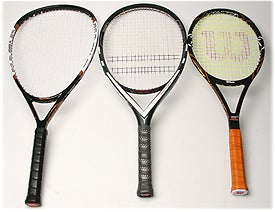 Power is directly related to head size - a larger head will providemore power than a smaller head, all other things being equal. A largerhead also offers a larger hitting area and sweetspot, providing moreforgiveness on off-center hits. Today’s racquets are offered in headsizes ranging from 85 to 135 square inches, with the most common being95-110. These head sizes offer a compromise between power and controlfor many players. Generally speaking, a smaller racquet head appeals tomore accomplished players seeking more control, while larger racquetsappeal to beginning and intermediate players seeking more power and alarger sweetspot. Length Power is directly related to head size - a larger head will providemore power than a smaller head, all other things being equal. A largerhead also offers a larger hitting area and sweetspot, providing moreforgiveness on off-center hits. Today’s racquets are offered in headsizes ranging from 85 to 135 square inches, with the most common being95-110. These head sizes offer a compromise between power and controlfor many players. Generally speaking, a smaller racquet head appeals tomore accomplished players seeking more control, while larger racquetsappeal to beginning and intermediate players seeking more power and alarger sweetspot. Length
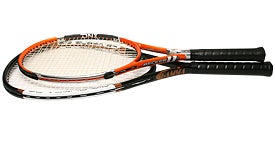 Racquets are available in lengths ranging from 27-29 inches, the legallimit for tournament play. Standard racquets are 27 inches long. Alonger racquet provides more reach on groundstrokes, added leverage onserves and slightly more power overall than standard length racquets,all other things being equal. For most players, switching from astandard length racquet to one that is 1/2 -1 inch longer doesn’tnormally present much of a problem. Most (but not all) longer racquetsare lighter than their standard-length counterparts to keep themmaneuverable. As racquet length increases, so does dynamic swingweight.Simply lengthening a 27 inch racquet without reducing weight wouldresult in a very unwieldy “club”. Weight & Balance Racquets are available in lengths ranging from 27-29 inches, the legallimit for tournament play. Standard racquets are 27 inches long. Alonger racquet provides more reach on groundstrokes, added leverage onserves and slightly more power overall than standard length racquets,all other things being equal. For most players, switching from astandard length racquet to one that is 1/2 -1 inch longer doesn’tnormally present much of a problem. Most (but not all) longer racquetsare lighter than their standard-length counterparts to keep themmaneuverable. As racquet length increases, so does dynamic swingweight.Simply lengthening a 27 inch racquet without reducing weight wouldresult in a very unwieldy “club”. Weight & Balance
 These two characteristics most influence how a racquet feels when youpick it up and when you swing it on the tennis court. Some basicconcepts - a heavy racquet is more powerful, more stable and transmitsless shock than a lighter racquet (all other things being equal). Alighter racquet is more maneuverable and thus, a player is able toswing it faster. If this is true, won’t a lighter racquet that is swungfast generate the same power as a heavier racquet that’s swung moreslowly? This question has been hotly debated ever since Wilsonintroduced their Hammer racquets back in 1990. Until then, racquetweights averaged 12-13 ounces and were balanced head light (or handleheavy). Wilson’s Hammer “technology” reduced overall racquet weight(10-11 ounces) but distributed more mass in the head, resulting in ahead-heavy balance. The idea was to improve maneuverability withoutsacrificing power by keeping weight in the racquet’s hitting zone.Since then, racquet weights have steadily dropped and now we havesub-10 ounce offerings from most manufacturers. Is lighter better? Notnecessarily. Well then, which racquet weight is best for you? Whatabout racquet balance? Is head-light, head-heavy or even balance best?In order to answer this question, you need a point of reference. Howheavy is your current racquet? Is it head light or head-heavy? Howmuch? If you don’t know, you can e-mail us at info@tennis-warehouse.com and we’ll send you the manufacturer’s specifications, if available. These two characteristics most influence how a racquet feels when youpick it up and when you swing it on the tennis court. Some basicconcepts - a heavy racquet is more powerful, more stable and transmitsless shock than a lighter racquet (all other things being equal). Alighter racquet is more maneuverable and thus, a player is able toswing it faster. If this is true, won’t a lighter racquet that is swungfast generate the same power as a heavier racquet that’s swung moreslowly? This question has been hotly debated ever since Wilsonintroduced their Hammer racquets back in 1990. Until then, racquetweights averaged 12-13 ounces and were balanced head light (or handleheavy). Wilson’s Hammer “technology” reduced overall racquet weight(10-11 ounces) but distributed more mass in the head, resulting in ahead-heavy balance. The idea was to improve maneuverability withoutsacrificing power by keeping weight in the racquet’s hitting zone.Since then, racquet weights have steadily dropped and now we havesub-10 ounce offerings from most manufacturers. Is lighter better? Notnecessarily. Well then, which racquet weight is best for you? Whatabout racquet balance? Is head-light, head-heavy or even balance best?In order to answer this question, you need a point of reference. Howheavy is your current racquet? Is it head light or head-heavy? Howmuch? If you don’t know, you can e-mail us at info@tennis-warehouse.com and we’ll send you the manufacturer’s specifications, if available.
Next,do you want a lighter, heavier or similarly weighted racquet?Head-light, head-heavy or evenly balanced? Chances are you don’t knowwhat you want until you play with a racquet. If this isn’t feasible,here are some guidelines on the advantages and disadvantages ofdifferent weights and balances.
Heavier, head-light racquets- preferred by mostprofessional players, these racquets are often referred to as being“traditionally weighted and balanced” racquets. They typically weigh11-13 ounces and are balanced 1/2 to 1-1/2 inches head light in orderto retain maneuverability. In most cases, these racquets are alsoreferred to as “player’s” racquets because they are generally morecontrol-oriented and designed for players who provide their own power.
Lightweight, head-heavy racquets - several years ago,Wilson discovered it was possible to make a racquet more maneuverablewithout reducing weight in the head. By removing weight in the handle,the racquet was lighter overall, while still retaining mass in theupper hoop, where ball contact occurs. This was the concept behindtheir Hammer and Sledge Hammer designs. Several other racquetmanufacturers have subsequently introduced lightweight, head-heavy (andevenly balanced) racquets. The advantages of this racquet type areincreased maneuverability without sacrificing power, especially ongroundstrokes. The disadvantages are less clear - some “experts” arguethat reducing weight increases the amount of shock transferred to thewrist, elbow and shoulder. Some players who have switched fromtraditionally weighted and balanced racquets to lightweight, head-heavymodels claim the racquets don’t feel “solid”. Clearly, you can’t getsomething for nothing. Reducing racquet weight will alter its feel -for better or for worse. Keep in mind, you can always add weight to aracquet if it’s too light. Reducing racquet weight, however, is almostimpossible. Frame Stiffness
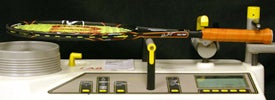 The amount a frame deflects during ball contact directly affects itspower potential. A stiffer racquet bends less, thus depleting lessenergy from the ball. A flexible racquet bends more, resulting in moreenergy loss. A common myth among players is that a flexible racquet,that bends back more, returns more power to the ball due to acatapult-effect. The ball remains on the strings for 3-5 milliseconds,much shorter than it takes a frame to recover. Consequently, a racquetframe doesn’t “return” energy to the ball, it absorbs energy - eithermore or less, depending on stiffness. Stiffer racquets don’t deflect asmuch on impact, resulting in less power drain than a flexible racquet. The amount a frame deflects during ball contact directly affects itspower potential. A stiffer racquet bends less, thus depleting lessenergy from the ball. A flexible racquet bends more, resulting in moreenergy loss. A common myth among players is that a flexible racquet,that bends back more, returns more power to the ball due to acatapult-effect. The ball remains on the strings for 3-5 milliseconds,much shorter than it takes a frame to recover. Consequently, a racquetframe doesn’t “return” energy to the ball, it absorbs energy - eithermore or less, depending on stiffness. Stiffer racquets don’t deflect asmuch on impact, resulting in less power drain than a flexible racquet.
Framestiffness doesn’t only affect power though. Control and comfort arealso at stake. Generally speaking, a racquet that offers more powerprovides less control. However, this is largely dependent on playertype and ability. An advanced player may prefer a flexible racquetbecause he or she has a long, fast swing and provides plenty of power.A stiff racquet might be too powerful for this player, resulting in toomany balls landing long. A beginning or intermediate player though, mayfind a stiffer racquet that doesn’t deflect as much on impact, providesbetter control. This may also apply to a more advanced player withshort, compact strokes. To a certain point, stiffer racquets aregenerally less comfortable than more flexible racquets. A very stiffframe will transmit more impact shock to the wrist, elbow and shoulderthan a medium stiff frame. Comfort is difficult to measure - eachplayer has a different perception of what feels comfortable. However,players with arm and/or shoulder problems will generally benefit morefrom a flexible to medium-stiff frame and should likely avoid stiff orvery stiff frames. A lesser known effect of frame stiffness is theamount of spin that can be generated. Generally speaking, stifferracquets provide less spin than flexible racquets because the ballleaves the stringbed more quickly. String Pattern
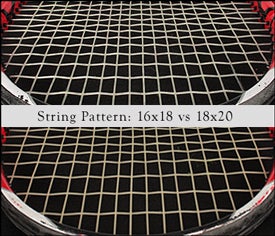 Often overlooked by many recreational players, string pattern densityinfluences many aspects of a racquet’s overall performance and feel.When we discuss string pattern density, we refer to open and dense (orclosed). Often overlooked by many recreational players, string pattern densityinfluences many aspects of a racquet’s overall performance and feel.When we discuss string pattern density, we refer to open and dense (orclosed).
An open string pattern will deflect more on impact than adenser pattern, providing greater ball rebound. Strung at the sametension (in similar racquets) an open string pattern won’t feel as“tight” as a dense string pattern. Open string patterns also allow formore spin potential, as the ball can embed itself into the stringsmore, due to their wider spacing. Players seeking more spin willbenefit from a more open string pattern. The price one may pay forthis, though, is reduced string durability. Open string patterns allowthe strings to move more freely, increasing abrasion which causesstring breakage.
A denser string pattern won’t deflect asmuch upon ball impact, resulting in less rebound energy. More closelyspaced strings will also offer less spin potential but will last longerthan a similar racquet featuring a more open string pattern. Playerswho don’t hit with much spin and are seeking enhanced control willgenerally prefer racquets with denser string patterns, as willhard-hitting topspin players seeking increased string durability. Grip/Handle Systems  |  | Asracquets become lighter and lighter, manufacturers are seeking ways toimprove comfort without significantly increasing weight. Incorporatinga shock and vibration dampening system in the handle is the most commonmethod currently being used. Dunlop’s ISIS, Head’s No SHOX, Prince’sAir and Volkl's’s Sensor handle systems offer varying degrees ofeffectiveness in reducing frame shock and vibration. Wilson and Yonexalso offer comfort systems located in the racquet shaft such asIso-Zorb and V-Con technologies. |  |  |  |
|
|